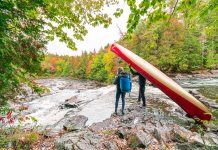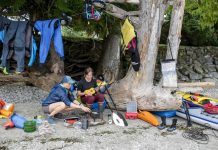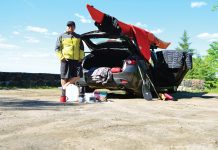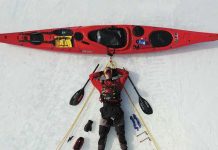Best known for his stunning captures of the night sky—from spectacular northern lights pulsing above mountain lakes to starlit paddlers, climbers and skiers—adventure photographer Paul Zizka has long had a fascination with shooting after dark. “I love how the nighttime can turn familiar places into completely different experiences,” says the Banff-based lensman. Zizka’s work is inspired by his passion for wild places, a connection that’s reinforced through his instantly recognizable self-portraits. “We live in a cluttered world. You have to put effort into making that connection and then when you’re out there, under the stars, it just feels so right.”
HOLD STILL
The magic of astrophotography is how the camera reveals all these elements—aurora, stars, moonlight—that the naked eye cannot see. All we see are little points of light; everything else is left to the imagination. There is so much to dream about. The key to capturing night photos is a sturdy tripod, like my Manfrotto MK055XPRO3-BH, that holds the camera perfectly still during minutes-long exposures.
PERFECT TIMING
Including a person in a landscape image can convey a sense of vulnerability or belonging, or make an image more relatable. Often I am out shooting alone, so the human in the frame is me. At first, it seemed like a chore, running back and forth to the camera to change settings and fix any compositional issues. But eventually the self- portrait aspect became a part of the photographic journey, and I enjoy the challenges it brings. One essential tool to capture this sort of image is an intervalometer—a remote that allows you to trigger a timer so you can put yourself in the image.
BODY BUILDER
I shoot with a versatile Canon 5D Mark III SLR camera. I can photograph astro, fast action and landscape all with the same camera. It’s super durable and easy to operate, which is important in the dark when I’m shooting by feel.
LENS CRAFTER
My Canon 16–35mm f/2.8L has been my workhorse lens since I started doing photography. I love this wide-angle zoom’s versatility, and its relatively light weight. I also carry a Canon 70–200mm f/2.8L telephoto lens to get sharp and dramatic mountain shots. And my fast prime, Canon’s 24mm f/1.4L, is perfect for night and…
GET FILTERED
Two of my go-to filters are a circular polarizer and a neutral density (ND) filter. Use a polarizer to add contrast to a blue sky or to eliminate reflections—perfect for shooting water scenes on bright days. I use a three-stop ND filter to achieve long exposures without waiting for low light, usually to emphasize subtle motion that a shorter exposure would not record. For example, capturing the silky flow of water or grasses blurred by the breeze.
LESS IS MORE
Your camera pack needs to protect all your essentials, without restricting access to your gear. It should be comfortable and weatherproof, like Lowepro’s Pro Runner BP 450 AW II backpack. Shooting in the backcountry for extended periods, I’m committed to using only the gear I carry. Deciding what I need depends on the duration of the trip, the location, how technical the terrain will be and what I want to accomplish.
SELF-PORTRAIT
This shot was captured on a very dark night on the remote atoll of Fakarava, in the Tuamotus, French Polynesia. After finding a foreground that complemented, even mimicked, the Milky Way above, I proceeded the way I usually do: adjust composition and settings, drop headlamp on the spot where I need to stand, set focus, set intervalometer to shoot continuously, enter the scene, try different body positions, then return to the camera to see if anything needs fixing. The skies are incredible in this part of the world, but the profound darkness pushes the equipment to its limits. As well, each set of incoming waves washed over my feet and swirled around the tripod, which made things a little nerve-wracking
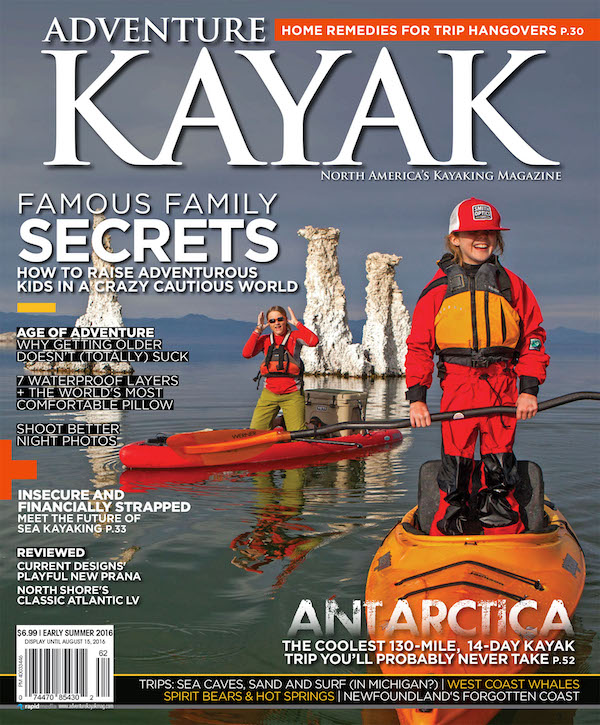 This article originally appeared in Adventure Kayak Early Summer 2016 issue.
This article originally appeared in Adventure Kayak Early Summer 2016 issue.
Subscribe to Paddling Magazine and get 25 years of digital magazine archives including our legacy titles: Rapid, Adventure Kayak and Canoeroots.




